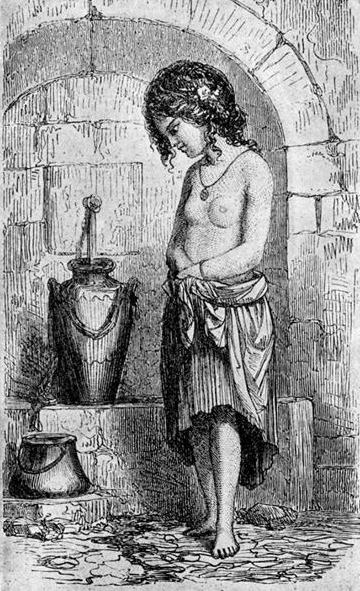
Romanian Gypsies: Historical Background--Medieva/Early Modern Period

Figure 1.-- This is a French engraving dated 1842, showing a Gypsy girl in Bucharest. Unlike pgotographs, we cannot know how accurate such drawing are are these images and how much they reflect stereotypes. At the time in Wallachia and Moldavia, however, Gypsies were still held as slaves. It seems unlikely that Romania girls, even serfs, at the time would go without a top anywhere in Europe. The same was not the case for Gypies. We see photographs not only Gysey childen without clothes, but even adult women without tops. This was, however, much less commonly than the situation for children. We suspect this was even more true for slave gysies. The caption read, "Jeune fille Isygane à Bucharest" meaning Young Gypsy girl in Buchrest.
|
|
The region now making up Romania has a substantial Gypsey or Roma population. In fact Romania had and coninues to have the largest Gypsy population in Europe. The modern term for Gypsey is Roma, a derivation showing the Romanian origins of many European Gypsies. Gypsies were able to move within the Byzantine Empire.. There is no eviudence tht Gyopseys reached the rea of modern Romania dring the Byzntine era. The Byzantines lost control of the area ata fairly early time. Various emores controlled the area including th Bulrs and Mongols. By thate meuevl era, Hungry cintrolled the aream but local principlities begn to exert autonomy. And it is during this period that the first Gypsies reached the Balkans. Gypsies reached Wallachia (1385) and Moldavia (1370) even before the Ottoman Turks. The first Gypsies secured letters of protection from the King of Hungary. This provided legal status. Gradually the situation for Gypsies deteriorted. Cultural differences soon gave rise to disputes between Gypsies and local residents. Gypsies in Romania as in other countries gradually adopted Christianity as well as took on Romanian names, and learned Romanian. They have not lost the Rom language and use it when speaking among themselves. They also maintain their Rom music and customs in often tight-knit communities. As a result, a substantial Rom population did not integrate within Romanian society. The Rom arrived in Romania during the medieval feudal era. As a result they became slaves or serfs to the landowners (boyars) with few rights. An estimated 250,000 Roma were enslaved in the various regions which now make up Romania. This was part of the same process that created medueval serfs. It needs to be noted that serfdom in Eastern and Western Europe had differet chrinologies. The institution appeared first in Western Euripe and in Eastern Europe only became important while it was declining in the West. The Gypsies were required to work in Orthodox monasteries and for both landowners and local princes. Romanian Gypsies until their liberation (1856) were slaves/serfs. We see the term slave being used. They had a staus similar to that of serfs. They were not allowed to leave the property or fiefdom of their owners, meaning boyars and the Orthodox monasteries. One estimate suggests that there were some 102,000 Romani lived in the Danubian Principalities (1850). This was about 3 percent of the population (90,000 or 4 percebt in Wallachia and 12,000 or 1 percent in Moldavia). [Ungewitter] After their 1856 liberation, many Roms left Wallachia and Moldavia. This contributed to itinerate life style they became identuified with.
Sources
Ungewitter, Dr. F.H. Neueste Erdbeschreibung und Staatenkunde (Zweiter Band: Dresden, 1848).
HBC

Navigate the Boys' Historical Clothing Web Site:
[Return to the Main Romanian historical gypsy page]
[Return to the Main Romanian gypsy page]
[Return to the Main Romanian minority page]
[Return to the Main European gypsy page]
[Return to the Main Gypsy page]
[Introduction]
[Activities]
[Biographies]
[Chronology]
[Clothing styles]
[Countries]
[Bibliographies]
[Contributions]
[FAQs]
[Glossaries]
[Images]
[Links]
[Registration]
[Tools]
[Boys' Clothing Home]
Navigate the Boys' Historical Clothing national pages:
[Return to the Main Romanian page]
[Return to the Main countries page]
[Australia]
[Belgium]
[England]
[France]
[Germany]
[Ireland]
[Italy]
[Japan]
[Korea]
[Mexico]
[New Zealand]
[Scotland]
[United States]
Created: 5:55 AM 6/18/2018
Last updated: 5:55 AM 6/18/2018



